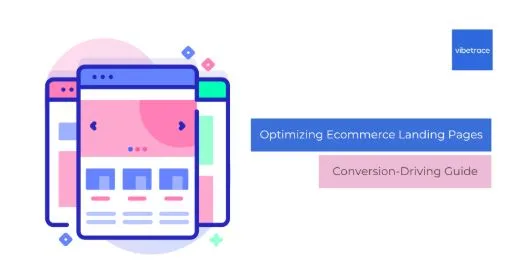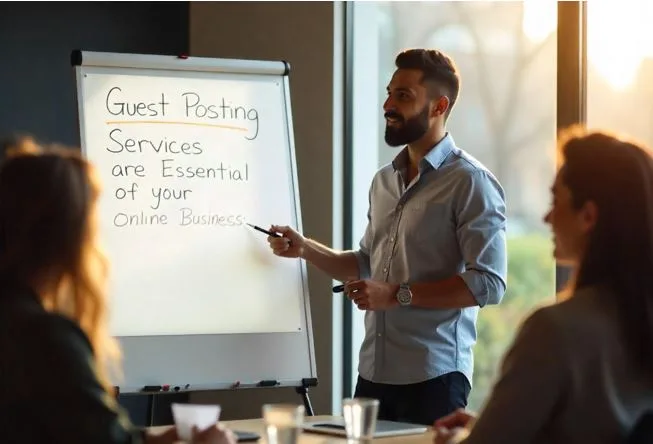Optimizing eCommerce Landing Pages: A Conversion-Driving Guide
eCommerce landing pages are the pages on an online store’s website where visitors land after clicking on an ad or link. These pages play a key role in turning visitors into paying customers. When these pages are well-optimized, they can increase sales, improve the effectiveness of advertising, and boost your overall return on investment.
This easy-to-follow guide covers the main steps to create high-converting eCommerce landing pages. First, it explains how to write compelling content and messages that grab visitors’ attention. Next, it looks at modern page layouts and designs that encourage visitors to take action. The guide also discusses important technical factors like website speed and making sure your pages work well on mobile devices, providing a smooth experience for users. Finally, it shares tips on testing and analyzing your landing pages so you can keep improving them based on real visitor data.
By applying these strategies, online stores can better connect with their customers and motivate more purchases through targeted, well-designed landing pages. Optimized landing pages help turn website traffic into revenue and support business growth. For companies looking to improve their online presence, working with a trusted eCommerce web design company can make all the difference in creating effective landing pages that drive results.
How Does Conversion Happen?
The AIDA model (Attention, Interest, Desire, Action, and Loyalty) is a cornerstone framework in marketing and sales. It outlines the distinct stages a potential customer goes through before making a purchase or taking a desired action. Understanding how conversion unfolds within each stage empowers businesses to craft effective strategies that guide customers towards their goals.
1. Awareness: Capturing Attention
- Objective: Grab the customer’s attention and introduce them to your brand or offering.
Strategies:
- Marketing campaigns: Utilize various channels like advertising, social media, content marketing, public relations, and influencer marketing to reach your target audience.
- Search engine optimization (SEO): Ensure your website ranks high in relevant search results to increase organic visibility.
- Public relations: Generate positive brand mentions through press releases, media coverage, and community engagement.
2. Interest: Sparking Curiosity and Engagement
- Objective: Once aware, pique the customer’s interest and encourage them to learn more about your product or service.
Strategies:
- Compelling content: Create informative and engaging content like blog posts, articles, videos, infographics, and webinars that address customer pain points and showcase your expertise.
- Social media interaction: Respond to comments and inquiries, participate in relevant conversations, and run targeted social media campaigns.
- Free trials or demos: Offer opportunities for potential customers to experience your product or service firsthand.
3. Desire: Cultivating Craving and Value Recognition
- Objective: Convince the customer of the value proposition your offering presents and build a strong desire to possess it.
Strategies:
- Highlight benefits and features: Clearly communicate how your product or service solves their problems, improves their lives, or fulfills their needs.
- Testimonials and case studies: Showcase success stories from existing customers to build trust and social proof.
- Promotions and offers: Provide limited-time discounts, free shipping, or bundled packages to incentivize purchase.
4. Action: Prompting the Decision and Conversion
- Objective: Guide the customer towards taking action, such as making a purchase, subscribing to a service, or contacting you for further information.
Strategies:
- Clear calls to action (CTAs): Use strong and concise language that prompts users to take the desired next step, like “Buy Now,” “Sign Up,” or “Learn More.”
- Streamlined checkout process: Ensure a user-friendly and secure purchase journey to minimize friction and abandonment.
- Retargeting campaigns: Remind potential customers about your product or service through targeted ads after they have interacted with your brand.
5. Loyalty: Fostering Long-Term Relationships
- Objective: Cultivate customer loyalty and encourage repeat business.
Strategies:
- Excellent customer service: Provide prompt, helpful, and personalized support to build positive brand experiences.
- Loyalty programs: Reward repeat customers with exclusive discounts, points, or special offers.
- Personalized communication: Tailor your marketing messages and recommendations based on individual customer preferences and purchase history.
Understanding Your Audience
Effectively optimizing eCommerce landing pages starts with understanding who your potential customers are. Developing buyer personas and researching audience needs lays the groundwork for crafting targeted, compelling page content.
An eCommerce developer can provide invaluable insights into your target demographics and help shape landing pages that truly speak to their wants and needs. By partnering with specialists who know the eCommerce landscape inside and out, you give yourself the best chance of connecting with visitors and converting them to customers.
Importance of audience research and personal development.
- Creating fictional representations of key customer segments allows tailoring content to their preferences and motivations.
- Leverage analytics and surveys to uncover demographics, common objections, and drivers when developing rounded personas.
- Keep detailed personas close at hand when drafting landing pages to ensure messaging alignment.
- Outline persona details like Xana, a busy young professional seeking healthy meal options, who values convenience and affordability when deciding between brands.
Identifying user needs, pain points, and buying journey stages.
- Determine personas’ goals and frustrations to address through products, services, and messaging.
- A customer may seek a better work-life balance or have trouble sticking to diets.
- Identify key pre-purchase decision stages to inform content priorities for different groups.
- Someone researching a category has different needs than a customer ready to buy.
- Guide audiences through awareness, consideration, and evaluation stages. Help them imagine post-purchase success to motivate sales.
Utilizing customer data and analytics to understand behavior.
- Analyze site metrics to uncover common conversion paths and high-exiting pages.
- Review heatmaps and recordings to improve page layout and content focus based on user navigation and interaction.
- See where visitors come from, what they click most, and how they convert to guide optimization.
- You may find videos are popular, but certain features have high exit rates.
- Leverage unprecedented visitor behavior insights from analytics.
Segmenting audiences for targeted landing pages
- Create customized landing pages aligned to different audience needs or traffic sources for greater relevance.
- Show different offers, features, testimonials, and messaging to various segments.
- Visitors from Facebook may see lead generation pages, while organic visitors see product listings.
- Sectioning your audience allows personalization at scale for improved conversion rates.
- Ensure consistent branding across targeted landing pages.
Crafting a Compelling Value Proposition
Your landing page headline and supporting content should focus on communicating a clear value proposition tailored to your target audiences. Follow these best practices when crafting an effective value proposition:
Identifying and communicating unique selling points (USPs)
- Research your competition to determine what makes your brand, products, or services truly unique.
- Communicate differentiated benefits in your headlines and messaging.
- For example, if fast shipping times set you apart, emphasize messaging around shipping guarantees.
Focusing on benefits, not just features
- Keep top-of-funnel visitors in mind by focusing more on the positive outcomes and feelings your brand provides.
- Lead with the problems you solve and the benefits you offer.
- Supplement with supporting features when relevant rather than leading with technical specs.
Tailoring value propositions to specific audience segments
- Adjust core value proposition elements like lead message, images, and testimonials to align with different visitor groups.
- Connect with distinct motivations and pain points.
- Create targeted landing pages for various ad campaigns, visitor types, and buyer journey stages.
Using clear and concise language with emotional triggers
- Grab attention quickly with compelling headlines using active, results-oriented verbs and descriptive adjectives.
- Supplement brief, hard-hitting statements of value with visitor-focused descriptive copy.
- Incorporate psychological triggers like exclusivity, social validation, or urgency where appropriate.
Optimizing Design & Layout
Effective landing page design goes far beyond aesthetics when it comes to driving conversions. Layout, imagery, copy, and UX details combine to create the user experience supporting your value proposition. Craft page presentation strategically with visitors’ first impressions, scanning behavior, and accessibility needs in mind.
This section covers core principles for visually communicating selling points and facilitating engagement through informed design choices and visitor-centric information hierarchy. Applying these best practices reinforces messaging while removing friction from the conversion process across devices.
Importance of First Impressions and Visual Hierarchy
- Optimize page design to guide visitors’ attention in an F-pattern: headlines, images, bullet points, supporting detail.
- Establish a clear visual hierarchy through the strategic use of fonts, sizes, colors, and spacing to make scanning easy.
- Grab attention with compelling headlines and emotional imagery upfront.
- Reinforce first impressions through strong alignment between headline promises and body content.
Leveraging High-Quality Images and Videos
- Include relevant, high-definition photos and videos that attract visitors’ attention while communicating core value propositions.
- Balance aesthetic appeal with meaningful demonstrations of key differentiators like product features, buyer journeys, and user-generated content.
- Ensure media follows accessibility best practices around color contrast, contextual descriptions, and optimized sizing.
Creating a Clean and Scannable Layout with White Space
- Strategically use negative space between elements so the page isn’t cluttered or overwhelming.
- Break content into short sections separated logically with ample margins around each block of text/media.
- Use background colors strategically behind calls-to-action so they stand out.
- Embrace minimalism with only essential info above the fold to ease visitor comprehension.
Optimizing for Mobile Responsiveness and User Experience
- Adopt responsive frameworks, ensuring desktop designs adapt seamlessly into mobile views.
- Check that tap targets and links have enough surrounding space for fat fingers.
- Limit sideways scrolling, which strains users. Favor vertical length.
- Enable one-click calls from all hero devices: iOS, Android, and more, with click-to-call extensions.
Accessibility Considerations for Diverse Users
- Ensure color contrast meets minimum ratios for visibility-impaired users.
- Provide contextual descriptions for all visual elements via alt text and ARIA labels.
- Make all functionality available by keyboard alone, without dependence on hover or complex gestures.
- Use heading tags for proper screen reader semantics rather than just styling text.
Powerful Headlines & Subheadings
Headlines and subheadings act as crucial entry points for visitors arriving at your landing pages. Craft them intentionally to capture attention and communicate relevance.
Crafting attention-grabbing headlines that speak to user needs.
- Research top questions and concerns from your buyer personas to incorporate into headlines. Address felt needs.
- Use emotional keywords and trending slang terms that visitors relate to.
For example:
“Finding affordable care just got easier.”
Utilizing subheadings to guide users and break up content.
- Split page content into logical sections led by descriptive subheads, labeling what each section covers.
- Subheads act like a table of contents, enabling quick scanning and navigation to areas of interest.
Incorporating keywords for SEO and user clarity.
- Include primary product, brand, and service keywords organically within headlines and subheads.
- This signals relevancy to search engines for organic traffic and paid ads.
- Helps visitors instantly recognize what they’re seeking.
Follow principles of effective title formulation and scannable content hierarchy through strategic headlines and subheads that grab attention while mapping the visitor journey within your copy.
Writing Persuasive Content
The copy on an eCommerce landing page must directly appeal to visitors’ motivations and priorities to effectively drive conversions.
Focusing on user-centric copy that resonates with the audience
- Speak directly to customers using “you” oriented messaging tailored to buyer persona concerns.
- Highlight benefits sought like convenience, quality, and community rather than brand-centric boasts.
Writing for clarity, conciseness, and emotional impact
- Break content into scannable sections with ample paragraph spacing and bullet points highlighting key differentiators.
- Lead with action verbs and vivid descriptors. Stay brief, linking to detailed specs as needed.
- Incorporate psychological appeal by discussing positive outcomes from purchase like joy, confidence, and belonging.
Addressing user objections and pain points directly
- Research common barriers holding customers back and alleviate worries proactively through thoughtful messaging and guarantees.
- Offer free trials, money-back promises, or low-risk options to overcome distrust.
Utilizing storytelling and social proof effectively
- Share relatable stories conveying what success with your offering looks, feels, or achieves like through descriptive narratives and testimonials.
- Show visual indicators of trust and credibility like logos, ratings, press features, and community size.
Compelling Calls to Action (CTAs)
Calls-to-action (CTAs) turn interest into leads and sales through clear click prompts guiding visitors to convert.
Importance of clear and actionable CTAs
- Lead visitors directly to next steps with unambiguous clickable buttons like “Start Free Trial” or “Buy Now”.
- Use action words like “Get”, “Join”, “Download” so users know what to expect upon click.
Optimizing CTA placement, color, and language
- Place primary CTA buttons above the fold in easy-to-spot locations like page headers or content endpoints.
- Make CTAs stand out visually with high contrast colors contrasting with the surrounding palette.
- Tailor button text for each audience segment’s preferences using emotional appeal and trending slang.
Using A/B testing to determine the most effective CTAs
- Test placement, sizing, color, copy, and form factor through ongoing experiments measuring engagement.
- Iteratively optimize CTA elements to maximize desired actions from visitors.
Avoiding misleading or confusing CTAs
- Never use vague CTAs like “Submit” or “Go” that don’t communicate the post-click action transparently.
- Keep branding consistent across steps so users who arrive at Order Confirmation after the “Buy Now” click aren’t confused by shifting messaging.
Building Trust & Credibility
Establishing legitimacy and cultivating buyer trust should be central to any eCommerce landing page strategy.
Showcasing customer testimonials and reviews
- Curate genuine positive customer quotes describing transformative outcomes from using your offering. Highlight relatable emotions like happiness, confidence, and a sense of belonging.
- Embed dynamic widgets displaying verified third-party review ratings and feedback. Show average scores and a sample of recent reviews.
Displaying trust signals like security badges and certifications
- Increase perceived reliability by highlighting encryption standards, money-back guarantees, and satisfaction promises visibly on the page.
- Link logos from any noteworthy featured placements, associations, or award wins. For example, highlight publications featured in.
Highlighting brand reputation and social proof
- Spotlight visual emblems of community traction like follower counts, engagement rates, or community member tiers. But avoid inflating claims.
- Reference any published articles, sponsorships, or relevant brand partnerships if affiliations are with credible, recognizable entities. Don’t name-drop tenuously.
Providing clear contact information and return policies
- Build visitor confidence by listing phone numbers, emails, live chat options, and convenient, easily accessible physical addresses.
- Transparently communicate all terms, conditions, and policies around payments, delivery, exchanges, and more, so users feel in control.
For maximum trust gains, back claims with credible proof while radiating professionalism and authority across messaging touchpoints.
Technical Optimization & Speed
With site speed directly impacting conversion rates, ensuring technically optimized landing pages is essential.
Importance of fast loading times for conversions
- Pages that load in under 2-3 seconds convert at significantly higher rates due to better user experience.
- Slow load times increase abandonment. Optimize speed with caching, image compression, and code minification.
Optimizing images and scripts for faster performance
- Compress and lazy-load images to cut load size. Set size limits and use next-gen formats like WebP.
- Minimize render-blocking JavaScript and defer non-critical scripts.
Utilizing website caching and a reliable hosting provider
- Implement server-side caching and CDNs to accelerate performance by storing key components for faster retrieval.
- Choose hosting optimized for your site’s needs with quality hardware and global connectivity.
Mobile-specific technical optimizations
- Enable GZIP compression to minimize transferred bytes to phones.
- Set viewport tag for proper mobile rendering.
- Design with tap targets, finger spacing, and touch input in mind.
Measure speed metrics regularly and address underperforming pages or bloated assets slowing conversions. Technical excellence and continuous performance tuning are the foundations of maximizing revenue.
A/B Testing & Iterative Improvement
A/B testing allows for systematic testing of changes to landing pages to optimize conversion rates based on visitor data.
Introduction to A/B testing and its benefits for optimization
- A/B tests compare a page element against a variation to determine which performs better.
- Provides data on messaging, layouts, and offers that best resonate with your audience.
- Iteratively improve page effectiveness and CX through continual controlled experiments.
Identifying elements to test and setting up experiments
- Test value proposition messaging, headlines, page designs, button colors, image styles, and more.
- Use dedicated tools like Optimizely or Google Optimize to set up tests and analyze performance.
Analyzing results and implementing data-driven improvements
- Review statistical significance and conversion rate lift to identify winning variations.
- Double down on what works by implementing improvements page-wide and across sites.
- Continue testing to further optimize performance over time as new ideas emerge.
Apply the scientific method to progress past assumptions. Let real visitor behavior guide design through agile testing and learning.
Additional Conversion-Boosting Strategies
Beyond the core optimization principles covered, a few additional advanced tactics can help take conversion rates to the next level.
Implementing exit-intent popups
- Detect when a visitor is about to leave a page and display a targeted pop-up offer to capture their attention. Using an intelligent pop-up maker tool that triggers customized pop-ups at just the right moment, you can pull visitors back in for a last chance at conversion before they bounce.
Incorporating coupon codes or special offers
- Provide exclusive promotional codes or discounts to incentivize desired actions from landing page visitors at critical dropoff points.
Retargeting visitors with personalized messaging
- Show customized displays, social ads, or special deals to visitors who previously landed on your page to re-engage them when they’re more likely to convert.
Experimenting with each stage of the funnel.
Each stage of the buyer’s journey, from awareness through consideration and evaluation, requires tailored landing page messaging and design strategy based on mindset.
Continually test new ideas while layering on advanced tactics like exclusivity triggers or retargeting to maximize conversion potential. Review heatmaps and session replays before expanding changes site-wide to ensure enhancements achieve the intended results.
Conclusion
Optimizing eCommerce landing pages is crucial for converting interested visitors into customers in today’s digital retail ecosystem. Aligning page content, trust signals, and technical capabilities with target user priorities and psychology is key. Start by intimately understanding your buyer personas through research to inform content strategy and messaging. Guide visitors seamlessly through sales funnels, addressing objections and building desire along the way.
Interweave credibility indicators while removing all friction surrounding calls-to-action. Enable effortless transactions through robust technical performance and flawless mobile responsiveness. Continually test new ideas with experimentation platforms and double down on what data confirms your audience best responds to. Keep pages fresh and aligned to emerging search intent through iterative optimization of both conversion path convenience and human connection.






